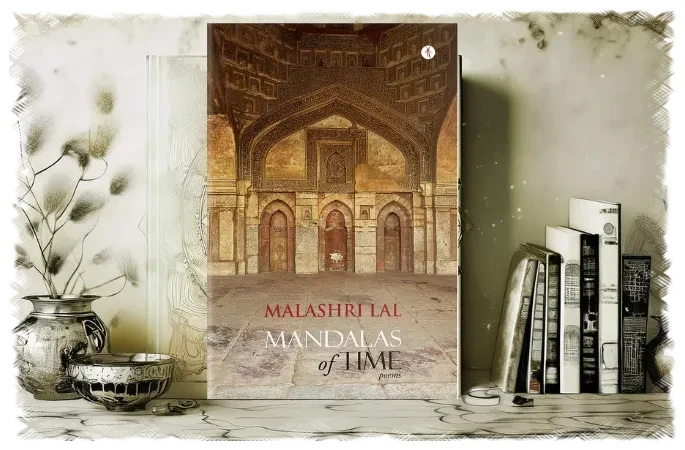Malashri Lal is an academic and creative writer based in Delhi. Mandalas of Time is her recent collection of poetry. In the Foreword to the book Bashabi Fraser writes, “We are introduced to the many themes and subjects that fascinate, move and inspire Malashri. Women are evoked or recalled from mythology, (Manthara Dasi) from the Hindu divine pantheon (the Sita poems which have the appeal of Malashri’s insights) and from history (Hawa Mahal), all given a voice by the poet’s sensibility”. With an elegantly supple body of seventy-five poems and remarkable control over the poetic idiom and the nuances of poetry, Mandalas of Time is an enthralling work. The volume has women in and out of mythology, their struggles at its core, and is artistically layered with metaphors about and meanings of longing, fulfilment, and illusion and hope across time and spaces. The title is intriguing and interesting. The poet tries to capture the expansion and contraction of time’s cavorting body as it runs in quicksilver speed through the forest of life or in the fluid images of relentless pursuit as the object of desire inexorably moves further and further away.
‘Ardhanareesvara’ sets the tone for the entire collection—the poet writes, “Sages, sculptors, storytellers knew the eternal truth/ That form belies essence much of the time/ Masculinity and femininity are the same word”. This intense relationship between men and women has an exciting premise. Roland Barthes conceptualises myth as a system of communication. Poetry, which has a language of its own, uses myth through its repository of symbols and metaphors. Indian classical literature is rich in myths and legends poems like “Diwali with Goddess Lakshmi”, “Krishna’s Flute”, “Radha’s Dilemma”, “Radha’s Flute”, “Rani Padmini Today”, “Sita’s Pankha” and Sita’s Rasoi” abounds them into its language. These poems are characterised by their virtuosic style as well as an assimilation of the different strands of Indian folklore, from Vashnavite influences to oral influences that the poet codifies into classical vocabulary—“Today Padmini’s sacrifice/ Is frowned upon as wrong/ I ask you if you can rewrite/ Values the past held strong?” “Sita’s Rasoi” marks a subtle shift from the mundane to the classical, making it impossible to ignore the meticulous codifications that function within the paradigm of myth—“Sita’s rasoi, a stone slab on which/ warmed single mounds/ of flour rest./ Rotis dance into a shape,/ flat, brown-edged, uneven rounds”. In its contemporary classical format, Mandalas of Time meanders through many phases and turns.
As the poet travels across time and spaces some fleeting moments dovetail into poetry –these poems are a close encounter with poetic explorations of places—In “Bellagio, Italy” Lal writes, “Sita was completely at home in what I thought was an alien space/ For she and the Celtic Goddess had a common sisterhood/ I Endurance and in Hope”. Like a pilgrim she undertakes the journey from the outer to the inner realm— Rabindranath’s clay house, Shyamoli in Shantiniketan, and after her mother’s departure she goes by the seashore to seek solace “Where the dark sky rests on the sparkle of stars,/ Living and dying are no longer apart” from Hawa Mahal to Delhi the journey continues. She also pays tributes to luminaries like Tagore, Gandhi, the Dalai Lama, and Maharani Gayatri Devi. As a contemporary poet, she has captured the fractured times during the recent pandemic– “Suddenly we are precious/ To be wrapped in protective gear/ Kept shut in a room/ Disallowed in drawing rooms/ And dining tables/ Kitchens and parks/ Because we are too precious/ To be ‘exposed’. “Critical Care”, “Seniors at Covid Time”, “Sita and the Pandemic” are a grim reminder of those dark days when life rolled in and out of ambulances, silence punctured by the sirens.
Mandalas of Time is a fascinating montage—of lived-in experiences, the influence of Indian classical literature and myths, the intermingling of the mundane with the life beyond, and the role that gender played in shaping the sensibility and vision of a poet—“My womb is fecund with life/ That doesn’t count in your chart of people/ Yes my intimate links are there/ Sharing my blood and my breath/ My thoughts and my solitude”. True to the design of mandalas the circularity of life/time uniquely stiches the innumerable impermanent moments of life keeping one grounded. Mandalas of Time influences the soul. The stunning book cover embellishes and enhances the aesthetic appeal of the volume.
Author: Malashri Lal
ISBN: 978-93-91431-99-0 (Hardbound)
Edition: (2023)
Price: Rs 500 $ 16.99
Published by Hawakal Publishers



